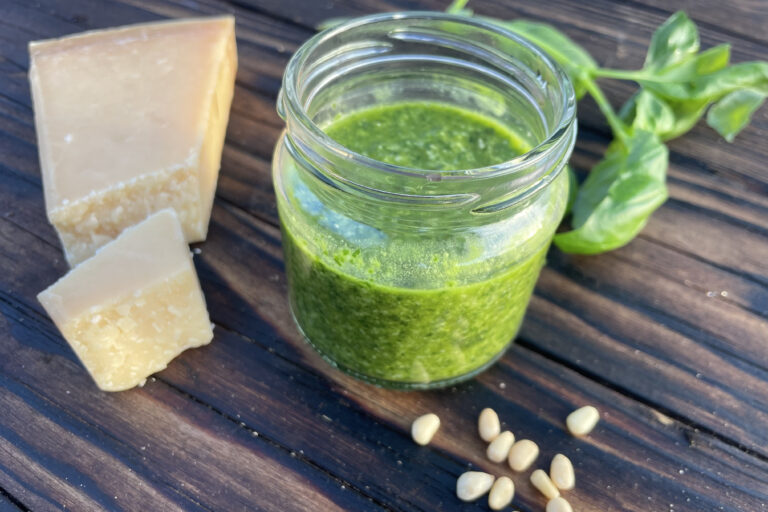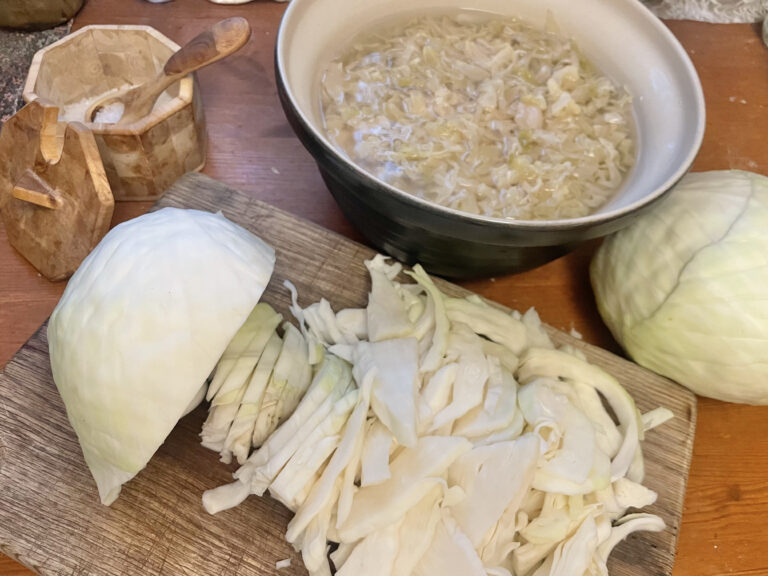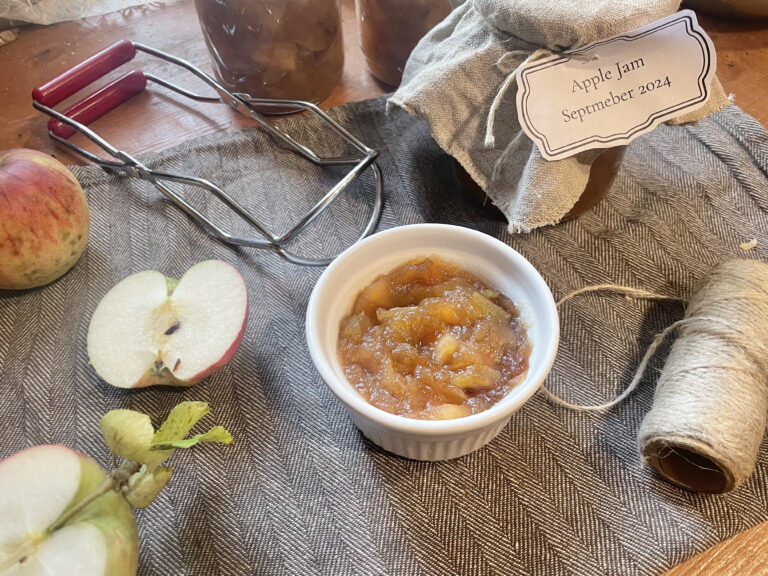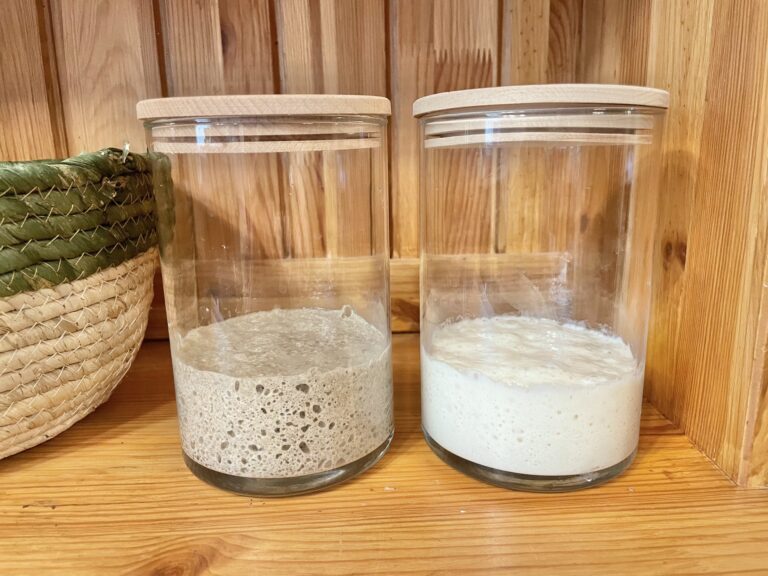This might not be the best way to start an article, but I have to admit: I’ve never liked pickles. I’ve never understood why people preserve dozens of pounds of them every fall. Do they actually eat that many pickles?

Anyway, my perspective changed after I made dill pickles myself. Homemade pickles have a special appeal and they’re nothing like grocery store pickles. I had a similar experience with mayonnaise—I wasn’t a fan before making it myself, but now I eat it on everything!
Before starting, come and follow me on Instagram, Facebook, and Pinterest!
Health Benefits of Fermented Cucumbers
In addition to being a tasty snack, fermented cucumbers offer numerous health benefits. Naturally rich in beneficial bacteria and healthy probiotics, fermented foods help restore gut microflora and aid digestion.
Besides supporting gut health, consuming fermented foods can help reduce the risk of heart disease. This good bacteria is also beneficial when mild cold symptoms appear, as they can provide extra immune support.
Pickles vs Lacto-Fermented Cucumbers
Anyone familiar with homemade fermentation likely knows the difference, but many people (myself included, in the past) don’t. The key difference is simple: pickling or marinated cucumbers require vinegar, while lacto-fermented cucumbers require a fermentation process using lactic acid bacteria, which naturally preserves the cucumbers in salt brine.
The Fermenting Process
To ferment cucumbers, all you need is salt and water. The fermentation period can range from a few days to several weeks. After 1-2 days in brine, the cucumbers develop a delicate, mildly tangy flavor. The longer they ferment, the tangier they become. After 1-2 weeks, they typically reach a robust sourness.
The easiest way to test is by tasting: if you like the flavor, they’re ready, regardless of the time. Fermentation time can vary slightly depending on the room temperature. Warmer environments speed up the process, while cooler rooms slow it down.

How to Get Crunchy Pickle
Most people prefer crisp pickles. The trick to keeping them crunchy is to cut off the blossom end of each cucumber before pickling. The blossom end contains enzymes that soften the cucumber. For a nice look, I recommend trimming both ends. Naturally, pickles won’t be as crunchy as fresh cucumbers, but they’ll still have a good crunch.
Ice Bath Soaking
Soaking cucumbers in an ice bath for 24 hours before pickling helps retain their crispness and makes it easy to wash off any excess dirt.
Salt Ratios for Fermenting
A good saltwater brine for fermenting cucumbers is 2–4%. Too much salt will make the brine hard to eat and can inhibit fermentation, while too little salt can result in bland pickles and may hinder the fermentation process. This recipe uses a 4% salt solution. Here’s how to measure it:
To keep it simple, aim to add 4% salt by weight to the cucumbers and another 4% to the water. For example, if you have 1 kg of cucumbers, you’ll need approximately 40 g of salt for the cucumbers plus an additional amount for the water.
- Calculate the salt needed for the cucumbers first, then set that amount aside.
- Prepare a small amount of water brine to start. For instance, if you use 100 g of water, dissolve 4 g of salt (4% of the water weight), plus the 40 g for the cucumbers. Pour this mixture over the cucumbers.
- Add more water as needed. For example, if you add another 500 ml of water, dissolve another 4% of salt (or 20 g) in that water and pour it in until the cucumbers are fully covered.
However, you don’t need to go through this lengthy calculation if you follow the recipe or already know from experience how much salt is needed for a given amount of cucumbers. Unfortunately, the exact amount of water required will vary depending on the size of the containers used, which makes it challenging to calculate the salt quantity in advance without knowing the specific fermentation container.
Choosing the Right Salt
For preserving, I recommend using pure sea salt or Himalayan pink salt. Avoid table salt, as it lacks minerals and may negatively impact your health. Personally, I believe Celtic sea salt is the best option for both preserving and general cooking.

Required Equipment
Container for fermenting
Weight to place on top (any suitable item like a stone or plate will work)
Cover to keep out debris and insects
Clean jars and lids for storing the pickles
Ingredients
Check the recipe card at the bottom of the post for ingredient quantities and nutritional information!
Cucumbers
Salt
Water
Seasonings (optional)
Fermenting Cucumbers
- Soak the cucumbers in cold water for a day. This step is optional but recommended.
- Clean the cucumbers by rinsing off any dirt in the soaking water, and trim off the flower ends (you can trim both ends if preferred).
- Place the cucumbers tightly into the fermentation container, fitting as many as possible.
- Calculate the salt amount needed based on the quantity of cucumbers if using a different amount than specified in this recipe.
- Dissolve the salt in water, then pour the brine over the cucumbers. Don’t forget to adjust the salt based on the amount of water added. Water temperature isn’t super important but avoid using hot water, as it may prevent the cucumbers from fermenting.
- Place a fermentation weight on top of the cucumbers to keep them submerged and prevent them from floating. Cover the container to keep out bugs and debris, but ensure it’s not airtight.
- Let the cucumbers ferment for 5–21 days in a dark place or at least away from direct sunlight. Taste periodically until they reach your desired flavor. You may have slightly sour pickles in as little as 1-2 days.
Cucumber Preservation
- Thoroughly wash jars and lids.
- Sterilize jars and lids by heating them in the oven at 212°F or by filling them with boiling water for a few minutes. I prefer using the oven, as it saves space and is quicker.
- As a precaution, briefly boil the lids as well.
- Place the fermented cucumbers in the jars, packing them tightly to save space. You can add extra seasonings like fresh dill, cloves of garlic, bay leaves, or spices if desired.
- Pour hot brine (same % as before) over the cucumbers, ensuring they are fully submerged.
- Screw on the lids. Wipe jar rims if necessary to prevent mold growth.
- You may process the jars in a water bath for 20 minutes if desired, though this is optional for fermented cucumbers. I always water-bath all my preserved goods for safety. If you’d like more details on water bath canning, see the next section.
- Place jars on a wooden surface or kitchen towel to avoid thermal shock. As they cool, the jars should vacuum-seal, with the lids noticeably pulled inward.
Water-Bath Canning
I process all my preserves in a water bath, it’s a safe and easy method. I use a large 10L pot with a towel or thick cloth (like a heavy bath towel) on the bottom to prevent the jars from clanking during boiling. The pot can hold five quart jars at once and I don’t feel that a special water bath canner is necessary.
Avoid putting cold jars in boiling water or hot jars in cold water, as this temperature shock can cause the jars to crack.
FAQ
How can I prevent mold from forming on the pickles?
Make sure the pickles are fully submerged in water, which greatly reduces the chance of mold.
Is the white layer on top of the pickles mold?
No, not necessarily. A white layer on top is often yeast, which is harmless and a normal part of the fermentation process. It can be mistaken for mold, and it sometimes takes a careful look to tell the difference. Mold usually has a distinct moldy smell and grows more visibly over a few days, making it easier to identify.
Can pickles with mold be saved?
Opinions differ on this—many old-timers would say you can simply skim off the mold and eat the pickles. However, it’s safest to discard any jar with mold since even a small amount can mean the mold has spread throughout the jar invisibly.
Is cloudy brine a bad sign?
No, cloudiness is normal and nothing to worry about.
Do I need special equipment or an airlock lid to ferment pickles?
Not at all! Regular containers work just fine. Large batches can be fermented in one big container, or you can ferment them directly in jars. Just ensure that insects can’t get into the container and that gases from fermentation can escape.
What if the pickles turn out too salty?
After fermenting, soak the pickles in unsalted water and repeat this process a few times. This will help reduce the saltiness.
Tips and Ideas
- For added flavor, try adding black pepper, mustard seed, allspice, dill, grape leaves, or garlic to the brine. But simple salted cucumbers are also delicious, so adding extras is entirely up to you!
- After canning, you can check if the jar is properly sealed by tapping the lid with your finger. The lid should make a high-pitched, clear clicking sound rather than a low, dull hum.
- If you don’t have a root cellar or a cool, dark place to store your cucumbers, you can keep them in your kitchen, and they’ll be perfectly fine.
- I hope this fermented pickle recipe serves you well, allowing you to enjoy fermented cucumbers all year round.


How to Make Lacto-Fermented Pickles with Canning Process
Homemade pickles have a special appeal and they're nothing like grocery store pickles
Ingredients
- 1 kg of pickles
- 40g of salt (for the cucumbers) and 80g of salt (for brine)
- 2 litres of water
Instructions
Fermenting Cucumbers
- Soak the cucumbers in cold water for a day. This step is optional but recommended.
- Clean the cucumbers by rinsing off any dirt in the soaking water, and trim off the flower ends (you can trim both ends if preferred).
- Place the cucumbers tightly into the fermentation container, fitting as many as possible.
- Calculate the salt amount needed based on the quantity of cucumbers if using a different amount than specified in this recipe.
- Dissolve the salt in water, then pour the brine over the cucumbers. Don’t forget to adjust the salt based on the amount of water added. Water temperature isn't super important, but avoid using hot water, as it may prevent the cucumbers from fermenting.
- Place a fermentation weight on top of the cucumbers to keep them submerged and prevent them from floating. Cover the container to keep out bugs and debris, but ensure it’s not airtight.
- Let the cucumbers ferment for 5–21 days in a dark place or at least away from direct sunlight. Taste periodically until they reach your desired flavor. You may have slightly sour pickles in as little as 2-3 days.
Cucumber Preservation
- Thoroughly wash jars and lids.
- Sterilize jars and lids by heating them in the oven at 212°F or by filling them with boiling water for a few minutes. I prefer using the oven, as it saves space and is quicker.
- As a precaution, briefly boil the lids as well.
- Place the fermented cucumbers in the jars, packing them tightly to save space. If desired, add extra seasonings like fresh dill, cloves of garlic, bay leaves, or spices.
- Pour hot brine (same % as before) over the cucumbers, ensuring they are fully submerged.
- Screw on the lids. Wipe jar rims if necessary to prevent mold growth.
- You may process the jars in a water bath for 20 minutes if desired, though this is optional for fermented cucumbers. I always water-bath all my preserved goods for safety. If you’d like more details on water bath canning, see the next section.
- Place jars on a wooden surface or kitchen towel to avoid thermal shock. As they cool, the jars should vacuum-seal, with the lids noticeably pulled inward.
Nutrition Information:
Yield: 1 Serving Size: 1Amount Per Serving: Calories: 120Total Fat: 3gSaturated Fat: 1gTrans Fat: 0gUnsaturated Fat: 1gCholesterol: 0mgSodium: 39176mgCarbohydrates: 24gFiber: 10gSugar: 11gProtein: 5g





